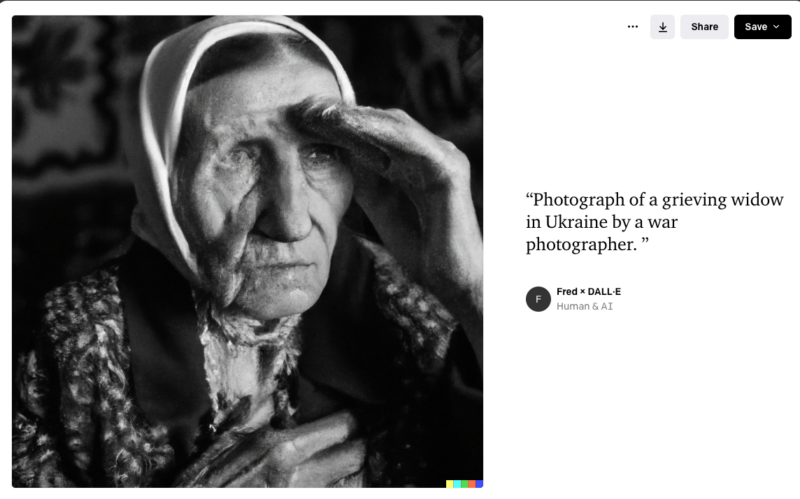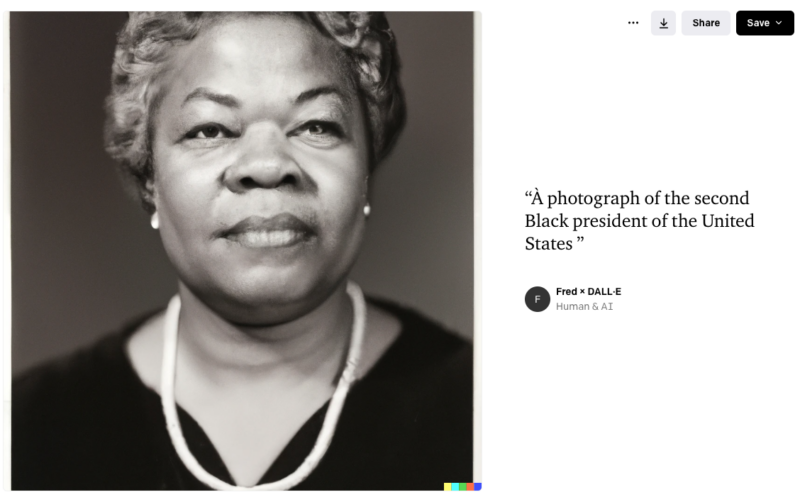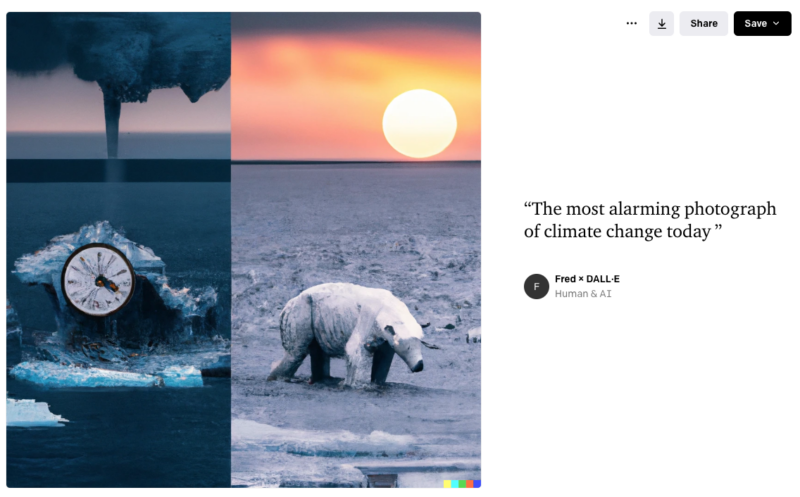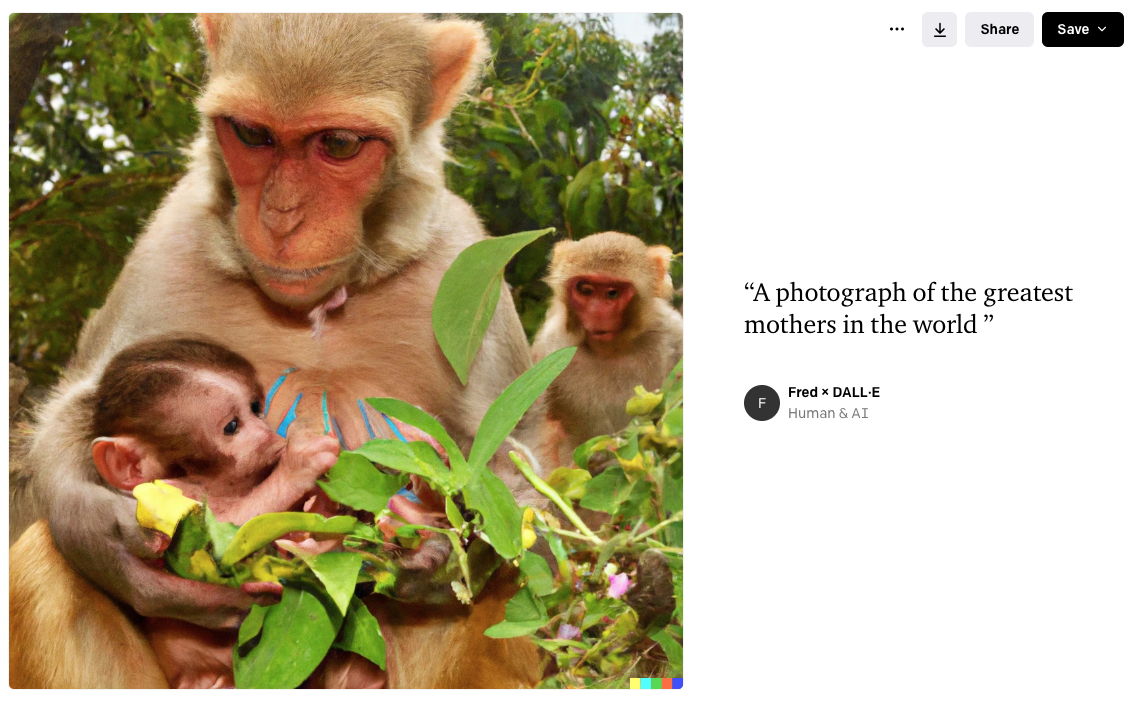In recent years, artificial intelligence engineers have used millions of real photographs—taken by journalists all over the world, and without those journalists’ permission—to train new imaging software to create synthetic photojournalism. Now anyone can prompt AI software like OpenAI’s DALL-E to generate convincing images of people or places that never existed, and of events that never occurred. In turn, those synthetic images continue to update AI software training.
Fred Ritchin, former photo editor at the New York Times, has been charting technological threats to photojournalistic integrity for years. In 1982, National Geographic published a cover photo in which the editor had moved two of the Pyramids of Giza closer together, for layout reasons. Ritchin wrote about the choice at the time and again this month in an article for Vanity Fair, comparing that simple distortion to “virtual time travel—as if revisiting a scene and photographing it again.” Now, as artists and agencies start to file suit against AI image generators, Ritchin is asking why the media is not more concerned about the enormous risk he sees artificial intelligence as posing to the credibility of visual journalism.
This week, I spoke with Ritchin, who is also dean emeritus of the International Center of Photography School, a former professor of photography and imaging at New York University specializing in visual media and human rights, and the creator of Four Corners, a software that embeds templated information in journalists’ photographs to facilitate a photographer’s authorship and contextualization. He is the author of three books on the future of imaging. Our conversation has been edited for length and clarity.
AD: Artificial intelligence software like DALL-E is increasingly making it possible for anyone to create their own synthetic imitation of photojournalism. What does today’s comfort with braiding together news and entertainment mean in the face of AI imaging software?
FR: There is an enormous interest in ChatGPT, in writing essays with artificial intelligence, writing news articles, writing movie scripts, and so on. But there’s very little concern about synthetic AI images and what AI can do to replicate a realistic photo of events and people who never existed. Now you don’t even need a camera. You could just say The war in Ukraine should look like this, and make the image. We really somehow have overlooked this challenge to the photograph as witness. It’s interesting to me: my Vanity Fair piece, which came out ten days ago—as far as I can tell, not one publication linked to it in the world, whereas what I am describing in the essay is enormous. We’re very close to destroying the credibility of the photograph. That’s a major step.
The other thing to add to the puzzle is, if you start making millions of synthetic images, then the new AI will be training on those images as well. The concept of history will become more and more distorted, because they’ll be training on the images that are not made by cameras, but made according to the way people want to see the world. What happens if people have five million images of World War II according to the way they want the war to look, and they look like photographs, so that’s what the AI is going to be training on in the future?

A synthetic image, not a photograph, created by OpenAI’s DALL-E in response to a prompt from Fred Ritchin, asking the artificial intelligence software to create a “Photograph of a grieving widow in Ukraine by a war photographer.”
How would you articulate the difference in the impact of photographs made by human beings as opposed to AI?
Photographs by themselves are made over a fraction of a second, so they need contextualization. The photographers have to be at the place they’re photographing. And they have to let the reader know some sense of what was going on, either by a photo essay—a group of photographs in sequence which build on each other and tell a story—or captions, text, audio, video, all the things you can now do in multimedia to contextualize the image.
When you do photojournalism, there are many people without power in society who you want to pay attention to. One of the founders of Doctors Without Borders said, “Without a photograph, there’s no massacre”. Because nobody believes the survivor—they’re too subjective in terms of recounting it. But the photograph itself is a credible document. Without a credible document, it’s like the tree falling in the forest, it will not make any noise. Making a synthetic image, you don’t have to be there. Hundreds of millions of images online have already been scanned, and you put in a text prompt, and you say, I want to see a waterfall in the Bronx. It could construct for you whatever you want, because you don’t have to experience it. You don’t have to be there.
And we can’t unsee things, right? So, with these synthetic images—made in the style of Getty photographers for example, created by AI that’s been educated with real Getty photographs—what is the impact of people seeing the images that aren’t real?
I think the impact is often that you assume the next one, even if it is an actual photograph, may not be. So you don’t have to respond to it.
I wrote in the Vanity Fair piece about how, in an exhibition in Israel, people who survived the Holocaust were asked about their traumatic memories as children. Now they’re making images according to those memories, we have these images that are getting more and more photorealistic, but not with cameras. If you’re a Nazi sympathizer, you could do the same thing and distort the historical record according to your own politics. The journalistic industry and others have to protect our archives, because once you start producing masses of synthetic imagery, you could skew history. You could show the South before the Civil War a whole different way.

A synthetic image, not a photograph, created by OpenAI’s DALL-E in response to a prompt from Fred Ritchin, asking the artificial intelligence software to create “A photograph of the second Black president of the United States.”
Looking at this lack of concern around synthetic images, do you think we are already somewhat desensitized to photojournalism?
The paradox is we are in the age of image, but the image itself is really often a camouflage. It’s used in, often, very superficial and distorting ways. If you go look at iconic photographs that changed the world—Vietnam, the Civil Rights movement, the picture of the earth from outer space in 1968—you don’t see that anymore. It’s a radical change, it’s the elephant in the room. We pretend that photographs in the twenty-first century are the same as the twentieth, and they’re not at all, they don’t do the same things. In twentieth-century photojournalism, it was really that kind of visceral sense of, There’s a girl being napalmed in 1972 in Vietnam. She’s nine years old, her skin is burning. And whether you’re politically for the war or against the war, the girl still was being napalmed, it was a reference point.
But we don’t have that equivalent today. The war in Ukraine, the war in Afghanistan—there’s no imagery like Eddie Adams’s photograph of the Viet Cong being executed, which would cause people to protest the war and carry big placards with the photograph on them.My sense is there’s been no iconic imagery like that since the photographs of Alan Kurdi, the Syrian boy who drowned off the coast of Turkey in 2015. Before that, you’d probably go back to Abu Ghraib, the photographs made by the US military of the torture of prisoners in Iraq. In this millennium, those photographs barely exist, certainly not enough to provoke a rethinking of policy on a national or global level. There are videos like the killing of George Floyd that have managed to provoke that sense of outrage. Often, it’s amateurs now who make the images that provoke discussion. The professionals, though excellent, rarely produce images that cause people to say, There was a twenty-year war in Afghanistan. What was it about? or provoke a large-scale societal discussion.
Our visual media has changed enormously. The sad thing is we’ve done almost nothing in the journalistic industry to preserve the credibility of the photograph. The argument about whether we should show photographs from Uvalde, Texas, of the schoolchildren who were massacred? Some people said, Oh, we have to show the photographs. Well, that’s wrong, in my opinion. Number one, because it would retraumatize the families. And number two, because it wouldn’t change any laws, in part because it’s very easy to reject photographs. It doesn’t have that visceral feeling that, in 1972, a nine-year-old girl suffering, burning from napalm had—it doesn’t do that at all. It’s just more images. If it’s pictures of the earthquake in Turkey, and it’s upsetting, well, now it’s easier to look away.
The reader has to understand, is this a manipulated image? Where is the borderline that divides those from an actual photograph? If you go into a bookstore, you ask for a nonfiction or fiction book, they know what you’re talking about. What’s a nonfiction photograph? What’s a fiction photograph? How much can a photograph be manipulated before it ceases to be photograph? We are not addressing those things. We’re not even interested in addressing those things.
I wonder why.
In 1839 or so, when photography began, the difference with the painter was that painting was synthetic, explicitly interpretive. It took a long period of time, it was often expensive. The camera itself had a mechanical side to it so that a human was authoring the image, but, at the same time, a camera was recording. It had a different weight in society than a painting did. At first painters said, Oh, photography is the death of painting. It wasn’t. In fact, it provoked a renaissance of painting with cubism, impressionism, minimalism, and so on, because painters could now use their imagination and not concentrate on representational painting.
Now, with synthetic images, the question is, what can it do differently than photography? For example, it can make synthetic images of the future. What do scientists say Manhattan will look like in twenty-five years if climate change continues and we don’t do anything about it? These images can be useful proactively. So instead of waiting for the disaster and photographing it, we actually do something about it in advance. We build walls or whatever needs to be done to protect Manhattan. There are things that artificial intelligence can add to the image equation, which can be very useful, and that’s the place we have to look.

A synthetic image, not a photograph, created by OpenAI’s DALL-E in response to a prompt from Fred Ritchin, asking the artificial intelligence software to create “The most alarming photograph of climate change today.”
Where do we revert to if the public becomes dismissive of photojournalism?
I don’t think you can ever revert. I think you have to move forward, and I think there are multiple ways of doing it. If you consider a photographer to be not just a camera carrier, but somebody who interprets events, people, landscapes according to their best knowledge, then you actually personalize it. They become authors just like a writer is an author. I would trust a writer who works for CJR perhaps more than just somebody with a blog, whom I may trust in different ways. The same thing with a photographer.
Then we have to start adding more contextualizing information—whether it’s video, audio, text. If you’re a professional making photographs, you have a greater responsibility to provide context than a citizen journalist or somebody working in social media. I do this with my class. I say, “You come from your country. Take fifteen images from social media that explain your country.” I remember a student of mine from China, and he had this photograph of middle aged people holding hands in the middle of the street in the afternoon. And I said, “What’s it about?” He said, “Well, their kids are taking the exam to get into university in the building next door, and they’re stopping traffic so it’ll be quiet for their children to take the exams.” And I said, “I learned more about your culture just from what you’re saying than I do in most newspapers, because you’re curating from the inside. You’re interpreting it for us.” The people who know what’s going on in the different cultures have to become the curators. Otherwise nobody’s going to go through the mass of images that are available on social media and elsewhere.
I also think publications have to be very clear on their own code of ethics. In the old days with black-and-white film, for example, you could change the contrast of an image to a certain extent. You could crop it, you could get rid of dust spots, but that was all okay. I like to think of photographs as quotations from appearances, so you could treat it the way a writer treats a quotation. You cannot redo the words within quote marks. You know, that’s not a quotation anymore. We have to come up with new standards, so the reader knows immediately: this is a photograph, or this is a synthetic image, or something else.
This is an enormous burden on the reader, the viewer, to fact check the photographs, until the industry sorts out how to regulate it.
The burden on the reader has to be as light as possible because nobody’s going to do all that research. People may have ten minutes a day to get the news. They have to go to work, make dinner, take care of the kids. They need a credible source.
You wrote about asking DALL-E for the “iconic photograph that is so horrible it would cause wars to stop.” The software produced an image of a woman looking through a camera, a small girl next to her shielding her eyes from the view. The camera itself is distorted as though by the scene they face. And then “a photograph of the greatest mothers in the world,” in which the AI gave you an image of an ape-like creature holding its baby. I assume you’ve played around with it more than just those two questions?
There are many such surprises. When I asked for the most alarming image of climate change, I got a diptych showing an oil geyser and a clock on one side—presumably showing how little time we have left to solve what is going on—and melting ice, a polar bear and a full sun on the other. I thought it was complex and nuanced, and produced in only seconds. There are many cases of AI being racist and misogynist and idiotic, but there are some cases where it’s really quite interesting. I’ve been working with philosophers, jazz musicians, painters, asking for imagery to be made by the AI from their point of view. If Plato would photograph, or Einstein, or a quantum physicist, what would the photographs look like?
The AI itself often does that as well. People are absolutely correct in their criticism of AI being trained on datasets which are often really awful. But simultaneously, just like when you assign a photographer, you have certain expectations and often get the stereotype back because nobody wants to upset the editor. The problem is we’re using AI to replicate previous media, in this case photography, and the potential for distortion is enormous.
How can photojournalists protect themselves and their livelihoods right now?
I don’t think it’s up to them alone. What they need to be doing is thinking of themselves as authors, as opposed to, you know, “shooters,” which is a word that I really detest. Often they’re just being asked to illustrate somebody else’s point of view. And I think that has to stop. They have to be respected by photo editors, text editors, editors in chief, as having their own integrity, their own autonomy, and their own ability to interpret situations.
In other words, we have to go back to the photo essay; really have an informed point of view, not just the person making the single image or get stuck in a sideshow in which you front load it for the most exciting pictures, for clickbait. The photo essay, to me, is the highest form of visual journalism, in which a photographer actually is allowed to have a point of view with complexity, nuance, depth. We need to reinstitute that as much as possible in a multimedia format, which would allow the potential for audio, for video, for text, for multiple languages, for the input of the people being depicted. Stuff that you may not have been able to do before.
And build media literacy. You have to be explaining to readers what different kinds of images are synthetic, manipulated photographs for illustrations, etc. You need transparency: We don’t modify images once they’re made, except for contrast or except for cropping, or whatever it would be. But make the explanations simple, don’t make it forty pages. Make it very evident, so the reader knows, and you know it. Keep working day by day to restore trust. Photographs are increasingly going to fade away and diminish unless we act quickly. And I think we’re going to be much the worse for not having them.
Other notable stories:
- Media Matters for America is out with its annual assessment of climate coverage on broadcast TV. The group found that news shows on ABC, CBS, NBC, and Fox Broadcasting collectively devoted slightly more airtime to the climate crisis in 2022 than in 2021, which was itself a high-water mark. The coverage, however, accounted for only one percent of all programming and was not always well framed, Media Matters found.
- Last week, I wrote in this newsletter about Matilda Bliss and Veronica Coit, journalists with the Asheville Blade, in North Carolina, who face trial on trespassing charges following their arrest while covering a sweep of a homeless encampment. According to the Freedom of the Press Foundation, newly released police body-camera footage in the case shows that officers targeted Bliss and Coit because they were filming the sweep.
- I also wrote recently in this newsletter about Andrej Babiš, the populist Czech politician and media magnate who failed in a bid to become the country’s president. I reported at the time on rumors that Babiš might soon look to sell his media portfolio. Now Vojtěch Berger reports, for the International Press Institute, that that scenario is looking more likely, due to a proposed new law that would ban politicians from owning news outlets.
- According to the Committee to Protect Journalists, at least fourteen journalists or media workers were “detained, harassed, or attacked” while covering crucial elections in Nigeria this week. Bola Ahmed Tinubu, a politician from the ruling party, was declared Nigeria’s president, though opponents have challenged the result. (ICYMI, CJR’s Feven Merid wrote about Black American journalists who went to Nigeria in the eighties.)
- And in the UK last year, Matt Hancock, the health minister for much of the pandemic, handed over thousands of WhatsApp messages to Isabel Oakeshott, a conservative journalist who was ghostwriting his pandemic memoir. Now Oakeshott, a fierce critic of lockdown measures that Hancock promoted, has given the messages to the Telegraph, a right-wing newspaper. Hancock’s allies have accused Oakeshott of breaching an NDA.
ICYMI: Jacaranda Nigeria Limited
Amanda Darrach is a contributor to CJR and a visiting scholar at the University of St Andrews School of International Relations. Follow her on Twitter @thedarrach.

